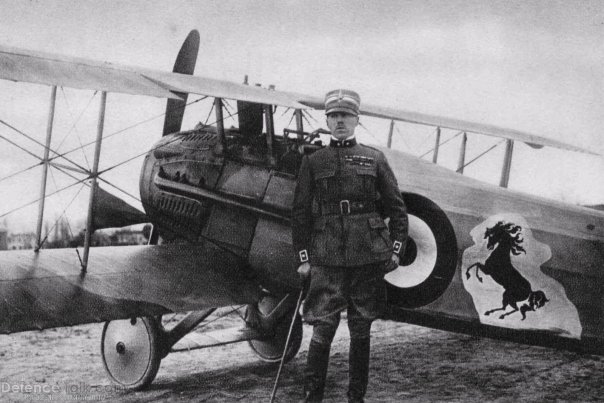
As far as is known, Major Baracca never even sat in a racing car. “So what’s he doing here then?” You rightly moan. Well, take a squint at the badge on the side of his plane, look familiar at all?
19-Dec-22 historicracing.com
The Major was one of Italy’s most successful WW1 era pilots, racking up 35 victories in his short career, and was also the commander of the elite 91a Squadriglia, known as the “Squadron of Aces”, whose badge of honour was the rampant stallion on a yellow background.
In fact Baracca later had his entire plane painted yellow, and got himself the windy nickname of “The Cavalier of the Skies”. In June of 1918 he failed to return from a mission and played no further direct role in either WW1 or this column.
Enzo Ferrari had become interested in cars and engines during the 1900s, when his father, a railway engineer, had become one of the first people in Modena to acquire a motorised contrivance of his own. When he too was called to military service in WW1, he persuaded the army that he was a fully competent mechanic. And since nobody really knew any better, he got the gig.
Back in civilian life, after the termination of the hostilities, Enzo’s wartime experiences were enough to get him a job as a mechanic and test driver for a little company called CMN. And it was here that the legend began. The exact details of his early career are extremely foggy. This is largely due to The Man himself, who’s recollection of events often exaggerated his own role, and commonly clashed with the memories of the other participants in his life.
Enzo always claimed that he took in his first competitive motorsport event in 1919, while driving for CMN. But it may actually have been in 1920. Nevertheless, he certainly raced CMNs around that time as he definitely drove one in the 1920 Targa Florio. The drive down to Sicily to take part in the race proved to be at least as adventuresome as the race itself. At one point, while driving at night, he and his co-driver went off of a mountain road and crashed into a snow drift, where they were set upon by a pack of wolves! Luckily they had a revolver in their toolkit, as you do, and were able to successfully recover the situation.
Ferrari later claimed that his chances of success in the race were ruined when the police made him follow slowly behind a convoy of vehicles led by a local politician, who’d decided to travel along part of the route in mid-race! A year later Enzo joined Alfa Romeo, and became a full-time racing driver. As a driver, Ferrari was competent, but not great. And certainly never as good as he seemed to believe he was. His greatest race would come at Ravenna in 1923, when, uncharacteristically, he completely dominated the event, and set a commanding lap record on his way to a popular victory.
After the race, he was approached by the father of Francesco Baracca, who invited him to visit the family’s local estate. When his son had been shot down, the squadron badge had been cut from the plane’s fabric skin, and sent to the family as a memento. Baracca senior now presented this to Ferrari, and suggested that he should adopt it as his personal talisman. And he did. Exactly why Baracca gave this important family heirloom to a relatively unknown young racing driver has always been something of a mystery. Enzo claimed it was simply because Baracca had been impressed by his “bravery and audacity”. Which may have been true. But another explanation may have been that Enzo’s older brother Alfredo (also known as Dino, the name that Enzo later gave to his first son), who died of fever while on active service in WW1, was thought to have been on the strength of Francesco Baracca’s squadron, and that the Ferrari family were probably already known to the Baraccas.
Some people have noticed that the Ferrari horse also seems to make an appearance in the centre of the rival Porsche logo. Sadly there’s no conspiracy afoot here. The rampant stallion on a yellow background also happens to be the coat-of-arms of the German city of Stuttgart. And is superimposed upon the Austrian Porsche family’s crest, simply in order to celebrate the company’s presence amongst the jolly Swabians. How very dull.